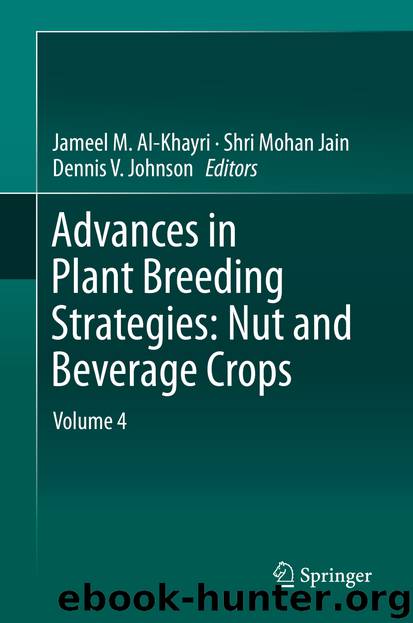Advances in Plant Breeding Strategies: Nut and Beverage Crops by Jameel M. Al-Khayri & Shri Mohan Jain & Dennis V. Johnson

Author:Jameel M. Al-Khayri & Shri Mohan Jain & Dennis V. Johnson
Language: eng
Format: epub
ISBN: 9783030231125
Publisher: Springer International Publishing
8.6.4 Enhanced Traits and Improved Cultivars
Mutations were intentionally carried out through mutagen treatments with the objective of generating variations for selection of better performing lines. Although the targeted traits are of commercial importance and health benefits, it was ensured that the farmers benefitted from those impacts. Mutants of flavorunner 458 with elevated levels of oleic acid replaced its parental line Florunner and other TSMV susceptible cultivars in parts of Texas. Subsequent to its selection, Florman occupied 80% of area in the 1990s. This improved parental line was used to develop 12 cultivars in production in the USA. The first high oleic cultivar released in the USA was a runner type named Sun Oleic 95R (Gorbet and Knauft 1997), since then that trait has been incorporated into Virginia and Spanish types (Simpson et al. 2003). Using Sun Oleic 95R as a parent in MABC, high oleic genotypes ICGV 06110, ICGV 06142 and ICGV06420 were developed in India (Varshney 2016).
Developing resistance is a rare phenomenon in crop plants. Available germplasm sources were found to have narrow genetic variations and hence induced variations for screening disease tolerance were attempted. Aspergillus-resistant mutant lines were developed by irradiating peanut varieties through gamma rays and somaclonal variations (Azzam and Khalifa 2016). Markers linked to Aspergillus were also developed. Early leaf spot, late leaf spot, rust and peanut rosette diseases cause up to 50% yield loss in peanut. Under moisture stress conditions Aspergillus infections increase and cause aflatoxin contamination of seeds. Terminal heat stress reduces the productivity and increases the chances of aflatoxin infection in the field. Rust is a major biotic stress of peanut causing about 50% yield loss. This is more prevalent in the Deccan Plateau of India. Introgression of rust resistant QTL from GPBD 4 in popular farmers’ cultivars, namely ICGV 91114, JL 24 and TAG 24, resulted in rust-resistant peanut lines, IPAHM103 with one dominant marker and GM2079, GM1536, GM2301 with three codominant markers (Varshney 2016).
High-yielding peanut varieties in India were achieved by consistent and continuous development of new varieties. By cultivating mutant varieties, peanut productivity in major peanut producing states, such as Gujarat, Andhra Pradesh, Maharashtra, Karnataka, Orissa and Rajasthan, have significantly increased. A drought-tolerant variety, TG-37A for Gujarat and Rajasthan and bold-seeded mutant varieties like TPG-41 and TLG-45 are most preferred for their earliness, seed dormancy and superior productivity. Among the peanut varieties, TAG-24, TG-26, TG-37A in the normal seed class, and TKG-19A and TPG-41 in the large seed class are the prominent varieties in India (http://www.barc.gov.in/pubaware/agri_social_inpact.html).
Download
This site does not store any files on its server. We only index and link to content provided by other sites. Please contact the content providers to delete copyright contents if any and email us, we'll remove relevant links or contents immediately.
| Automotive | Engineering |
| Transportation |
Whiskies Galore by Ian Buxton(41879)
Introduction to Aircraft Design (Cambridge Aerospace Series) by John P. Fielding(33064)
Small Unmanned Fixed-wing Aircraft Design by Andrew J. Keane Andras Sobester James P. Scanlan & András Sóbester & James P. Scanlan(32743)
Craft Beer for the Homebrewer by Michael Agnew(18140)
Turbulence by E. J. Noyes(7936)
The Complete Stick Figure Physics Tutorials by Allen Sarah(7307)
Kaplan MCAT General Chemistry Review by Kaplan(6867)
The Thirst by Nesbo Jo(6826)
Bad Blood by John Carreyrou(6552)
Modelling of Convective Heat and Mass Transfer in Rotating Flows by Igor V. Shevchuk(6391)
Learning SQL by Alan Beaulieu(6211)
Weapons of Math Destruction by Cathy O'Neil(6146)
Man-made Catastrophes and Risk Information Concealment by Dmitry Chernov & Didier Sornette(5921)
Digital Minimalism by Cal Newport;(5664)
Life 3.0: Being Human in the Age of Artificial Intelligence by Tegmark Max(5474)
iGen by Jean M. Twenge(5366)
Secrets of Antigravity Propulsion: Tesla, UFOs, and Classified Aerospace Technology by Ph.D. Paul A. Laviolette(5309)
Design of Trajectory Optimization Approach for Space Maneuver Vehicle Skip Entry Problems by Runqi Chai & Al Savvaris & Antonios Tsourdos & Senchun Chai(5011)
Pale Blue Dot by Carl Sagan(4912)
